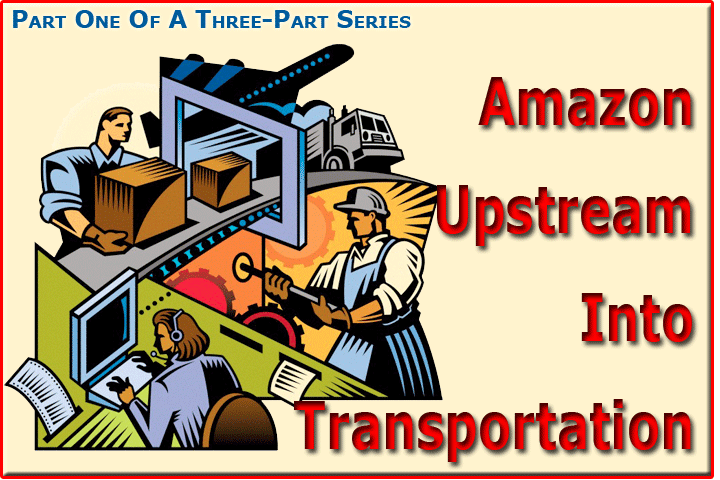
(Exclusive)—Rumors
that Amazon is one of three bidders looking to establish a presence
at Germany’s Frankfurt-Hahn Airport continue to mount. The location
would offer easy access to warehouses across Europe, potentially generating
cost savings and service improvements. It would also give Amazon better
access to Germany, Europe’s largest economy.
Such an investment would not be unexpected
given Amazon’s recent efforts to bolster its international distribution
network and reduce reliance on third parties, particularly the integrators
that currently fulfill many of its global freight and last-mile services.
Recently the company has been using a
Boeing 737 freighter to link fulfillment centers in Poland, Germany,
and the UK on a trial basis. A base at Hahn would enable the retail
giant to reach any city in Europe as well as a few in the Middle East
with the low-range B737—an option that could boost the attractiveness
of the Amazon Prime program.
Amazon China registered with the Federal
Maritime Commission as a licensed Ocean Transport Intermediary earlier
this year. This means it will be able to provide ocean freight services
for third parties, a significant move given the company’s market
clout and considering the ocean freight market’s estimated worth
of around $350bn annually. Amazon could eventually offer fulfillment
services from Chinese factories direct to customers in the U.S. and
Europe, a strategy that could vastly reduce warehousing and other inventory
costs.
Perhaps Amazon’s boldest recent
step into the transportation business was its deal in March with Air
Transport Services Group (ATSG), which will operate an air freight network
to serve Amazon’s U.S. customers.
The commercial agreement includes the
leasing of 20 Boeing 767 freighter aircraft to Amazon Fulfillment Services
by ATSG’s Cargo Aircraft Management, the operation of the aircraft
by ATSG’s airlines—ABX Air and Air Transport International—and
gateway and logistics services provided by ATSG’s LGSTX Services.
 “Since
last summer, we have been working closely with Amazon to demonstrate
that a dedicated, fully customized air cargo network can be a strong
supplement to existing transportation and distribution resources,”
said Joe Hete, (right) President and CEO of ATSG.
“Since
last summer, we have been working closely with Amazon to demonstrate
that a dedicated, fully customized air cargo network can be a strong
supplement to existing transportation and distribution resources,”
said Joe Hete, (right) President and CEO of ATSG.
Amazon has not been commenting much on
its efforts to secure more of its own supply chain capacity, but its
shipping costs have been rising for the last five years. Reports suggest
the retail giant has a strategy to expand its ‘Fulfillment By
Amazon’ service, which offers supply chain services to merchants
that sell products on its websites.
Elsewhere, it is claimed Amazon is planning
to launch a ‘Global Supply Chain by Amazon’ service, a step
that could give sellers the option to reach global markets via Amazon
at reduced cost—a major potential threat to many 3PLs and forwarders.
 Wolfgang
Lehmacher, Head of Supply Chain and Transport Industries at the World
Economic Forum, said Amazon’s move into global logistics and air
freight were designed to increase supply chain control, but does not
expect this to threaten incumbents just yet, although that could change
rapidly.
Wolfgang
Lehmacher, Head of Supply Chain and Transport Industries at the World
Economic Forum, said Amazon’s move into global logistics and air
freight were designed to increase supply chain control, but does not
expect this to threaten incumbents just yet, although that could change
rapidly.
“It’s similar to the move
of Chinese SF Express—one of the leading private express delivery
providers with its own ecommerce and retail business,” he said.
“Operating an air network is costly but at the same time an important
operational backbone.
“SF Express and Amazon gain more
control over service levels and can secure capacity, in particular important
during peak seasons. Cost aspects might play a role as well.
“In China, according to Reuter’s,
Amazon registered a subsidiary, Beijing Century Joyo Courier Service,
and filed an application with the Shanghai Shipping Exchange to serve
as a shipping broker for 12 trade routes, including Shanghai to Los
Angeles and Shanghai to Hamburg, Germany.
“All this indicates that Amazon
is preparing to set up a large global end-to-end logistics operation.”
Lehmacher also noted that Amazon had already
invested heavily in the infrastructure needed to manage more complex
supply chains. The acquisition of Kiva Systems—now Amazon Robotics—gave
it 173 logistics facilities worldwide, 104 in the North America region
with the rest spread across Europe and Asia. It has also been bolstering
its network of Amazon Prime Now centers to fulfill one-hour and two-hour
deliveries and has invested in last-mile experience by buying stakes
in Yodel in the UK and Colis Privé in France.
“In Germany, Amazon offers last-mile
delivery to customers in Munich through its own delivery operation—with
more than 200 delivery vehicles operated by a subcontractor,”
he said.
“After the UK, France, and Germany,
Amazon might eye the other larger European markets such as Italy, Spain,
and Poland.
“Complementary is Amazon’s
plan to introduce a locker network across Europe. Currently the company
is operating lockers in the U.S. and the UK. Building the capabilities
to service all customer touch points opens new opportunities to Amazon.”
According to Lehmacher, Amazon’s
strategy of increasing its end-to-end supply chain control is unlikely
to have a major impact on freight rates in, for example, the air cargo
market. However, Amazon might set new standards, in particular for last-mile
delivery. This would put pressure on traditional players in the supply
chain services industry.
“Driving the downstream logistics
value chain alone requires volumes,” he said. “Amazon is
probably one of the few players with sufficient volumes to set up a
viable end-to-end logistics supply chain.
“On the back of the newly built
supply chain operation Amazon could offer supply chain services to small
and mid-sized companies—a traditionally higher margin but difficult-to-service
segment.”
“This would well complement the
current offer to the small- and mid-sized customer segment, which is
core to Amazon’s strategy.
“Whether the developments will hurt
or stimulate the traditional supply chain players remains to be seen.
“Whether Amazon will enter into
frontal competition with the well-established global logistics giants
will depend on the value proposition Amazon is able to create.”
SkyKing
Last
week with Amazon shares skyrocketing, selling at about USD$678.00
a share, the company is wowing Wall Street. Stock value is coming
from Amazon’s core e-Commerce business as well as its cloud
computing division.
Although the landscape is strewn with forgotten dreams
and big losses of dotcom companies which flush with cash moved into
other businesses, Amazon’s move into the airline business
bears some watching.
Not that Amazon does not have challenges as it takes
off into the wild blue yonder.
Financial analyst Sucharita Mulpuru told USA Today,
“their economics are not as strong as other retailers and
are much worse than other established technology companies.”
Amazon turned a first quarter 2015 USD$57 million dollar
loss into a first quarter 2016 USD$514 million dollars net income. |
(Continued Next Issue.





